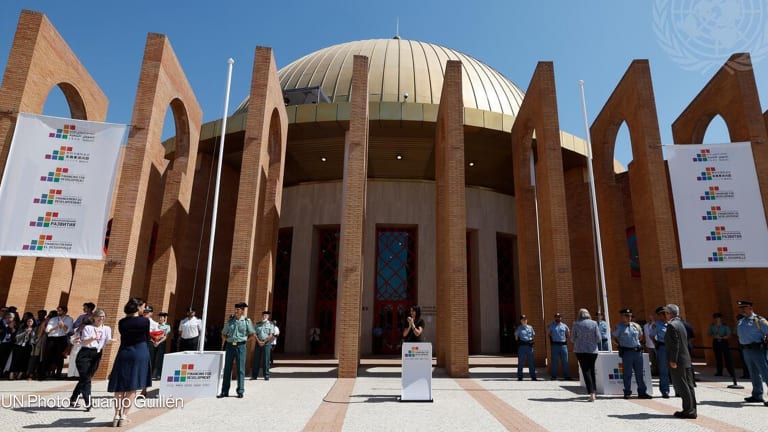A humanitarian emergency is bound to occur. What could a pandemic-era response look like?
Localization, remote work, and pandemic-focused preparedness are all new facets of emergency response, according to humanitarian organizations. But these will not change the core of what they do, experts say.
NEW YORK — As the COVID-19 pandemic drags on, the inevitability of a new humanitarian emergency — be it a destructive hurricane or an explosion like the recent one in Beirut — persists. Though some government lockdowns have eased, travel restrictions and health concerns for emergency responders and beneficiary communities remain. International humanitarian organizations say that they will still be able to respond quickly to an emergency in the era of COVID-19 but that response plans are shifting, relying more on local and regional partners and the increased use of remote work. “We know that we're living in a pandemic, and that changes the ways that we work. But it doesn't change the work that we do,” said Erynn Carter, senior director for humanitarian response at Mercy Corps. “We continue to plan to respond to a big disaster even in COVID. That will look really different. There might not be so many international staff on airplanes flying to various locations.” Already, approximately 85% of Mercy Corps staff members are from the countries where they work. For the International Rescue Committee, national staff members make up 98% of its teams. The pandemic is quickly reinforcing this growing trend, experts say. “I think COVID has accelerated our plans to move towards localization because of the international restrictions on travel,” Carter continued. She offered the example of the 2019 Nepal earthquake response, which was delivered mainly by national and a few regional Mercy Corps staffers. The model “reinforced” the importance of a locally led response, which Carter expects to now intensify. Following the Beirut explosions on Aug. 4, UNICEF quickly brought in 10 people to assist with the immediate response. The number was smaller than how many they might have added on the ground during prepandemic times, but it was supplemented with more remote workers, according to Manuel Fontaine, UNICEF’s director of emergency programs. “We managed to surge in. But then what we also do is that we are trying to see what we can surge remotely, if you will — so colleagues who can actually work for a response but don't need to be on the ground for some of the logistics, some of the HR [human resources] functions and things like that,” Fontaine said. Gordon Willcock, deputy director of emergency response at Direct Relief, said that the mandatory quarantine in his home country of Australia factored into his decision to not travel to Lebanon following the explosion, which killed about 200 people and injured more than 6,500. “That obviously factored into my thinking. If I've got to tack on an extra two weeks at the end of that, you know, it makes it pretty prohibitive with my family,” Willcock said. International travel for emergency response has become more of a “decision” than it was before COVID-19. “It's more of something that we need to weigh up with. You know, is it really necessary? We might have pulled the trigger on sending someone down to connect with local authorities a lot faster than we would right now. Is it really necessary for us to be there, or can we do it remotely?” he said. For many international humanitarians, especially those caring for young children, living with older relatives, or with preexisting health concerns, the answer might mean staying home and even, in some cases, reconsidering their career paths. “There were a lot of concerns from colleagues saying, ‘Well, you know, I don't want to leave my parents’ and all that, which is why we've been trying to be very flexible as we could, especially at the beginning,” Fontaine said. “But the impression I'm getting is that, progressively, people get a bit more familiar with the disease and some of the issues around it, and they are a little bit more willing to basically get back to business as usual.” “We know that we're living in a pandemic, and that changes the ways that we work. But it doesn't change the work that we do.” --— Erynn Carter, senior director for humanitarian response, Mercy Corps Other areas of emergency work are not so different from what they once were. Direct Relief, for example, has positioned hurricane preparedness packs along the Gulf Coast and Florida Panhandle as hurricane season is underway. “We can still do that without a problem,” Gordon said. In Lebanon, meanwhile, there was already a strong local humanitarian network that could quickly respond to the explosion without the support of an influx of international humanitarian workers, experts say. A response in another country with less local capacity, and more travel restrictions, could come with additional challenges. Humanitarian exemptions The initial wave of government lockdowns and travel interruptions as a result of the pandemic have largely subsided, according to humanitarian emergency responders who spoke with Devex. Initial concerns about sudden flight cancellations, for example, have eased, with the introduction of new United Nations humanitarian flight paths and the recent uptick in available commercial flights. But the work environment remains very complex. Many countries maintain mandatory quarantine periods for visitors and border entry restrictions, meaning that emergency responses could vary depending on a government’s willingness to grant humanitarian exemptions for travel — given concerns that outside visitors could bring in the coronavirus. Limited access to rapid COVID-19 testing is another concern that could complicate a humanitarian response. The International Medical Corps is testing all people traveling on a mission prior to deployment. Mandatory quarantines can be waived, in some cases, with proof of a negative COVID-19 test within 72 hours of a flight, according to Bob Kitchen, vice president of emergencies at IRC. But that is not always possible, given the testing availability and scarcity of rapid testing in many countries, including the U.S. “Getting tests that are processed quickly enough for us to have enough time to fly around the world, entering a country with enough time on that 72 hour window, is proving really challenging. And then once they're in the country, many countries have regulations for newly arrived visitors,” Kitchen told Devex. “So, the emergency team that is arriving on the ground to launch immediate programs would have to do so from a remote basis from a motel room for between five to 14 days, depending on the country.” Understanding humanitarian crises COVID-19 is making many humanitarian crises and development challenges more pronounced, reducing access to schools, health care, and employment. But tracking humanitarian trends has also become harder, in part because of lockdowns and movement restrictions. Insufficient COVID-19 testing also means that organizations like IRC are looking to their own staff members’ health as an indication of high COVID-19 rates in a particular country. “We’ve got flooding across Central Africa, and we are having to go really much deeper to get data about what’s happening and the scale of the crisis to inform our decisions,” Kitchen said. IMC anticipates a need to rethink how it targets its humanitarian responses — for example, focusing on elderly people who are at a higher risk of becoming severely sick or dying because of COVID-19. “We had a drill recently with Hurricane Laura where now we need to take into consideration not necessarily just the hurricane, but certain aspects of the hurricane that can also exacerbate the community transmission level of the novel coronavirus,” said Solomon Kuah, director of IMC’s U.S. programs. “In some ways, we get a little bit more targeted to certain aspects of a natural disaster that can take a vulnerable population to infection and actually increase that vulnerability.” Preparedness is also looking different for CARE International, which is now working to ensure that there is a sufficient quantity of personal protective equipment for staff members and partners and that all programming is adapted to the COVID-19 context. Available, sufficient funding to respond rapidly to a disaster is one concern for Debbie Santalesa, senior emergency response specialist at CARE. “I wish I had a crystal ball. I know how things are, and I pray every day we don't have any major emergencies, just for everybody's sake. The reality is that for COVID, it has its impact and will have its impact for at least for through the end of the year, if not longer,” Santalesa said. “But I think in terms of the work we're doing, you know, we're very cognizant and aware of what the impact could be.”
NEW YORK — As the COVID-19 pandemic drags on, the inevitability of a new humanitarian emergency — be it a destructive hurricane or an explosion like the recent one in Beirut — persists.
Though some government lockdowns have eased, travel restrictions and health concerns for emergency responders and beneficiary communities remain. International humanitarian organizations say that they will still be able to respond quickly to an emergency in the era of COVID-19 but that response plans are shifting, relying more on local and regional partners and the increased use of remote work.
“We know that we're living in a pandemic, and that changes the ways that we work. But it doesn't change the work that we do,” said Erynn Carter, senior director for humanitarian response at Mercy Corps. “We continue to plan to respond to a big disaster even in COVID. That will look really different. There might not be so many international staff on airplanes flying to various locations.”
This story is forDevex Promembers
Unlock this story now with a 15-day free trial of Devex Pro.
With a Devex Pro subscription you'll get access to deeper analysis and exclusive insights from our reporters and analysts.
Start my free trialRequest a group subscription Printing articles to share with others is a breach of our terms and conditions and copyright policy. Please use the sharing options on the left side of the article. Devex Pro members may share up to 10 articles per month using the Pro share tool ( ).
Amy Lieberman is the U.N. Correspondent for Devex. She covers the United Nations and reports on global development and politics. Amy previously worked as a freelance reporter, covering the environment, human rights, immigration, and health across the U.S. and in more than 10 countries, including Colombia, Mexico, Nepal, and Cambodia. Her coverage has appeared in the Guardian, the Atlantic, Slate, and the Los Angeles Times. A native New Yorker, Amy received her master’s degree in politics and government from Columbia’s School of Journalism.






